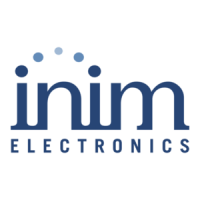48 Installation
Anti-intrusion control panels
• The port reserved for access to the web server. Set at 80 at default.
• The Programming port (up/downloading). Set at 5004 at default.
GATEWAY
The gateway is the access point which each peripheral connected in the network uses to
reach the Internet. In the case of a minimum configuration, the gateway is the router.
The parameter to be configured is the IP address of the gateway and must belong to the
IP address class of the internal network (for example, 192.168.1.1).
DNS
This is the server used for the resolution of Internet names in IP addresses (for
example, it translates www.google.com in 209.85.129.99). The parameter to be
configured is the IP address of the DNS server, depends on the network connection
provider (Telecom, Vodafone, etc.) and therefore must be requested from the network
administrator.
SSL
This is a protocol for HTTPS connections. The security of the connection with the
computer is guaranteed by integrated cryptography. Secure connection of mobile-
devices is guaranteed by SSL protocol
For a secure HTTPS connection, users must connect to the SmartLAN/G using the SSL
port (443 at default) or through the programmed one.
• Default SSL port (443): https://192.168.1.92
• Customized SSL port (xyz): https://192.168.1.92:xyz
3-11-2
Configuring a router
Remote access to the SmartLAN requires knowledge of the public IP address of the
router, assigned by the provider (Telecom, Vodafone, etc.) for Internet access. This
address can be either static or dynamic, thus conditioning remote access to the router:
• Connection to a
dynamic public IP address
The provider may re-assign a public IP address in either a temporized manner or at each
router connection, thus modifying it. This complicates remote access to the router.
In order to resolve this problem, many routers have access to a dynamic DNS service
for the association of dynamic IP addresses to host names (for example
www.dyndns.com). It will be necessary to register a “dynamic DNS host” and set the
parameters provided by the ISP (for example, user, password, domain, etc.) on the
router. The router will update the dynamic IP address periodically with the registered
static hostname (for example, http://casamia.dyndns.org). In this way it will be possible
to have remote access to the router by means of a univocal name that is linked to the
public IP address.
• Connection to a static public IP address
This type of connection links to a public IP address that is always the same. In this
case, it is possible either to access the router directly through the fixed IP address,
or purchase a domain (for example, www.casamia.com) that is capable or re-routing
packets to the fixed IP address assigned by the connection provider.
Once remote access to the router has been achieved, it is necessary to route the
incoming connections to the SmartLAN. To distinguish these connections, use the
previously programmed “IP Address” and “Port” parameters. During this
programming phase, it is strongly recommended that you contact the network
administrator in order to avoid configuration conflicts.
It is therefore necessary to access the router page reserved for “port forwarding”
(sometimes called “virtual server”) and set up the route directions of the two services
the SmartLAN is enabled on.
• Web server port
•• communication protocol: TCP/IP
•• external port: 8080 (or any other free port provided by the network administrator)
•• internal port: 80 (or the one selected during the programming phase)
•• IP address: IP address of the SmartLAN
•Web server SSL port
•• communication protocol: TCP/IP
•• external port: 443 (or any other free port provided by the network administrator)
•• internal port: 443 (or the one selected during the programming phase)
•• IP address: IP address of the SmartLAN
• Programming port
•• communication protocol: TCP/IP
•• external port: 5004 (or the one selected during the programming phase)
•• internal port: 5004 (or the one selected during the programming phase)
•• IP address: IP address of the SmartLAN

